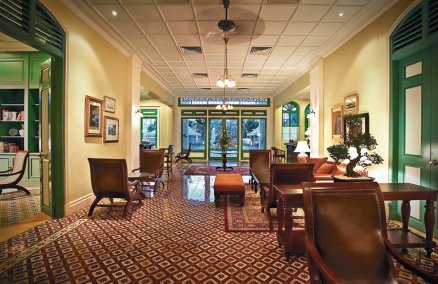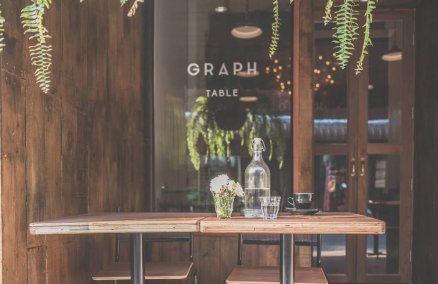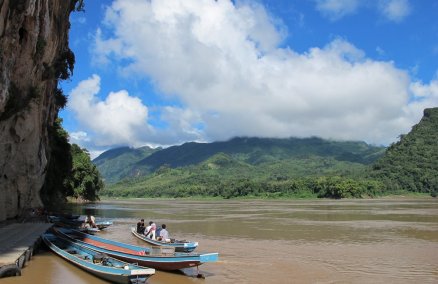Doi Angkhang has long been known as the place where HM the King’s Royal Projects began, in a bid to rid the Northern hills of opium fields. Some 30 years later, the valley is a lush green, replete with popular attractions like beautiful gardens and fruit plantations. Those who crave cool weather will also be delighted to note that temperatures here sometimes drop below zero—during late December and early January, frost is commonly found on the grass. Here’s what’s making present-day Doi Angkhang more than just a retreat from the heat.
Farm Route
You might regularly hear about food sourced from the Royal Projects but Ang Khang Royal Agricultural Station is actually where it first started. On the 2.2-kilometer ring road around the station, you can hop out and visit plantations where they grow various kinds of cool weather fruits such as pears, peaches, strawberries, persimmon, kiwi fruit, pomegranate and blueberries. One you can’t miss is the Japanese apricot plot, which has been used as the setting for many romantic scenes in Thai movies and lakorn (just think of Nadej and Yaya in Torranee Ni Nee Krai Krong). Here, apricot trees dot the lush green carpet-like field. Opposite is the equally enticing vegetable demonstration plantation where you will be amazed by the colorful vegetables grown in a big open-air greenhouse. For flower lovers, too, this is a paradise. There are many flower gardens inside the station which are a sight to behold, especially in winter, such as the English Rose Garden and the Bonsai Garden. The most fascinating is probably the outdoor Eighty Garden, situated in front of the Angkhang Club, while the Flower Green House is another can’t-miss for its botanical wonders. When the afternoon arrives, a visit to the Tea Storage is another good option as tea is another popular product grown here. You can walk around or opt to ride one of the mules that the station offers during winter—contact the station in advance at 053-450-107/9, www.angkhangstation.com. The real good news is this year is set to be the first year that the Japanese sakura will bloom at the station, in late November, as opposed to the praya suekrong (Thai cherry blossom), which bloom late December or early January.
Sunrise Route
Chasing the sun is a popular activity in the hills of the North. There are many spots to catch the sunrise, the easiest to reach being at the Angkhang Military Base, near the camping point on the way to Nor Lae village. Choose from the wooden terrace at the military compound or the small hill at the camping point. After watching the sun come up, you might want to stretch your legs on the 30-minute Nor Lae trekking route which offers great views of the mountains over in Myanmar. Another great way to welcome the morning is by paying a visit to the strawberry fields and tea fields of the 2000 Plantation—nothing like a view of a misty mountainside to start the day. You can also spot gulab panpee (rhododendron) some 4.5 kilometers from the station. The best time to see the flowers here is December-February when the fresh blooms go all the way up to the summit, called Nern Pankao, the highest hill in Angkhang at 1,928 meters. Afterwards, in March, you’ll find lots of fireflies around the station, too.
Cultural Route
There are three main villages where visitors can get a glimpse of the local hill tribe culture, the most popular being Nor Lae village. The villagers belong to the Palong or Dara-ang tribes and are the main people responsible for growing the produce at Ang Khang station. Sat on the hill above the village is Nor Lae military base where you can enjoy another panoramic view of Myanmar’s mountains. Another can’t-miss village is Khob Dong village, home to the Mu Ser Dam tribe who live here in bamboo houses dotting the hill. The slightly more developed Ban Luang village, meanwhile, is a Yunnan village where a lot of Chinese migrated to during WWII.
Food Route
You don’t need to search far and wide for a feed as there’s plenty of good stuff to be found inside the Royal Agricultural Station. Head to Angkhang Club for a true taste of the valley with a long list of dishes ranging from hill tribe specialties to produce from the royal projects. Their kha moo with man tou (braised pork with fried Chinese bun, B100) is particularly moreish, as is the nam prik Angkhang (B80), made with the hill tribes’ fermented soy bean paste recipe. Salads are also highly recommended with the ingredients picked fresh from the station. Other dining options require a bit of exercise, but if you head to Ban Luang Village you can try the tasty khao soi (curry noodle) made in the Yunnan style at Ali (053-969-431, 081-022-6570). The soup here is clearer and not as thick as the typical Northern version. Their salapao (stuffed Chinese bun) with black bean is a great dessert option, too.
Essentials
Where to stay
Angkhang Station Guesthouse.
Cozy accommodation is offered on-site at the station from two people per room up to five people per room. Rates during winter are B1,500-B5,500 per night. 053-450-107/9, http://www.angkhangstation.com
Angkhang Nature Resort.
Owned by the Royal Project Foundation but run by Onyx Hospitality Group, the resort is sat in front of the station. As the weather gets pretty cold in the winter, the hotel is equipped with electric blankets. Rates start from B3,000 for a mountain view room and B3,500 for a garden view. 053-450-110, http://bit.ly/16nQ6MH
How to get there
By Car
From Chiang Mai, take Highway No.107 passing Chiang Dao district until you reaching Fang district then turn left onto Road No.1249 for the station.
By Bus
Make your way to Chiang Mai then choose from several options to get to Doi Angkhang. The easiest way is to catch the daily commute offered by both vans and buses at Chang Puak Gate. When you reach the entrance of Doi Angkhang, there will be a small bus to take you up to the station.
Advertisement















